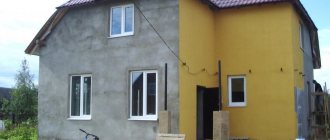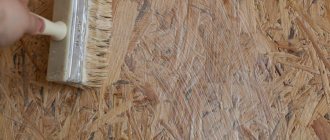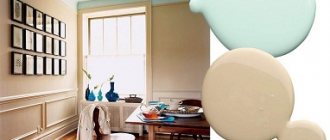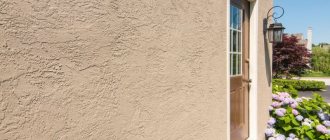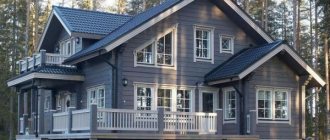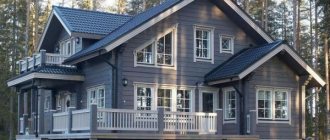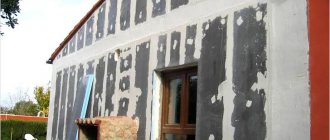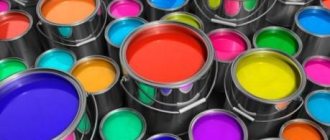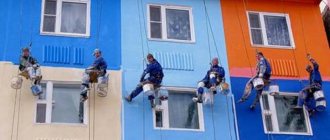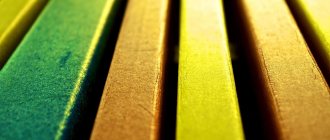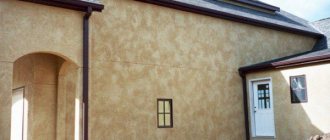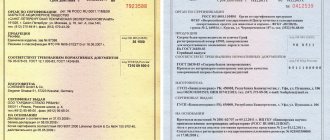How to choose facade paint?
In order to answer this question, we must first determine what type of external wall we will work with. Will the wall be in frequent contact with dirt, lots of sun or lichen? The next step will be to determine the type and important parameters of the paint.
To begin with, we will discuss the most important parameters that façade paint should differ in:
Vapor permeability
This is a very important parameter especially for wooden walls. The high vapor permeability of the paint creates a repellent effect of water from the facade and ensures effective removal of moisture outside the building.
Manufacturers determine this parameter in two different ways: the most common is how much water falls on the surface of one square meter within 24 hours (the more, the better), although there is also the so-called Sd coefficient (here it’s the other way around: the lower the better).
Drying time
Of course, if we talk about this parameter, the smaller it is for façade paint, the better. However, keep in mind that this may be related both to the period after which the paint layer dries, and separately to the time after which you can lay down another layer.
Viscosity and composition
This indicator determines the quality of the paint and, therefore, its cost. Paint fillers can be very different (they may include resins, lime and cement). The fewer there are, the better. If the paint contains a lot of fillers, and at the same time has low viscosity, this means that it is of low quality.
Consumption
This indicator means how many liters of paint are consumed per 1 square meter (one layer).
Resistance
We are talking, first of all, about resistance to washing, abrasion, cleaning, UV radiation and scratches.
Waterproof (water-repellent) paint
Since façade paint is applied to an external wall, it must perform protective functions against excess moisture. Water resistance is inextricably linked to the absorption capacity of the paint, so we must buy a product that has the lowest possible water absorption rate.
Do-it-yourself plaster painting of external walls
Structural facade paints are applied to the surface using a pneumatic or electric paint sprayer, roller or brush. To get to the top of the building you will need to collect scaffolding.
Work progress:
- Mix the paint well with a construction mixer.
- The most convenient tool for application is a spray gun. If this device is not available, then a round brush or roller is used for painting. The paint is applied in strokes, which are applied in random directions - horizontally, vertically and diagonally. This technique creates a homogeneous layer.
- Regardless of the type of facade paint, it should be applied in two layers. Lime compounds are applied in three balls.
- There should not be too long breaks in the work process. When the paint dries, it creates visible borders. It becomes clear which part of the wall was painted earlier and which later.
- The next layer is applied only when the previous one is completely dry.
- To protect wet walls from the penetration of dust and precipitation, they are covered with plastic films.
READ MORE: 6 Best foams and mousses for hair – Rating 2019
Important! The paint surfaces acquire all their protective properties after the layer has completely dried. The paint should dry quickly. This characteristic will allow the work to be carried out in late autumn weather. The method of painting on plastered surfaces is not complicated.
It is recommended to take note of even the smallest rules. Every detail will ensure a good, long-lasting result. The façade coating must be durable and provide protection. Plus you will need to achieve high external characteristics.
Which façade paint is the best?
In addition to determining the most important parameters of paint for the facade of a house, we should also distinguish between their varieties, each of which is adapted to specific conditions:
- Acrylic facade paint - in recent years it has often been used by owners of private houses because of its practicality and practically “indestructibility”. This type of paint got its name due to its acrylic resin content. Other advantages of the paint are significant flexibility and resistance to stains. The biggest disadvantage is the relatively low vapor permeability. Acrylic paint should be applied to organic and mineral substrates (except calcium and silicate plasters);
- Silicone facade paint is also a common choice of homeowners. Silicone facade paints are valued for their fantastic protection against water. In addition, it is vapor permeable and is also characterized by increased hydrophobicity, due to which water flows along the facade and does not penetrate through the walls. In addition, these types of paint are very resistant to sunlight and low temperatures. The disadvantages of this type of paint and varnish products include low flexibility and abrasion resistance, as well as a relatively high price. Silicone facade paint is recommended to be applied to surfaces made of concrete, mineral plasters, fiber cement boards and bricks;
- Acrylic-silicone facade paint - we can say that this is a slightly improved version of conventional acrylic products. This type of paint and varnish material is characterized by better breathability and water resistance;
- Silicate facade paint is characterized by very high resistance, mainly to lichens, dirt, abrasion and changing weather conditions. In addition, silicate paints for facades have very good breathability and water resistance. Disadvantages include the inability to use it on organic surfaces and the fact that it can burn out;
- Silicone-silicate facade paint - thanks to the use of silicone resins, it is characterized by increased water resistance and vapor permeability. Can also be used on organic surfaces;
- Cement facade paint is by far the cheapest of all presented. Despite decent vapor permeability, such paints and varnishes are characterized by high water absorption, which also leads to susceptibility to dirt. They are also fickle and can change their color;
- Vinyl exterior paint is a water-soluble product and is not very resistant to dirt, mold and mildew, moisture and scratches. Some may also have poor adhesion;
- Structural facade paint - it has a very high density, similar to plaster masses. Due to their high grain size, they are considered decorative paints. With the help of such paints and varnishes we can achieve the unique aesthetics of our façade.
Leading companies producing dyes for wooden facades
There are a huge number of manufacturers of paint and varnish products on the building materials market. Therefore, consumers have access to different paints for exterior woodwork; which one is best suited for protecting and decorating a wooden façade will help you understand a review of the highest quality paints and varnishes. It reflects the actual properties of the product, and not the stated and advertised characteristics. Therefore, the rating of facade paints for wood for exterior work will definitely be useful to homeowners and performers of work.
A wide range of facade dyes allows you to choose the best paint for protecting and decorating wooden surfaces Source derevyannyydom.ru
- 10th place
The paint and varnish production plant in Yaroslavl produces various compositions, including antiseptics, primers and varnishes. Among the popular products is a protective and tinting mixture called “Tekotex”.
The basis of this material is alkyd varnish. The composition also includes a solvent and fungicides. This mixture reliably protects the tree from various negative external influences. It also gives the façade a lasting color.
Yaroslavl paints for facade woodwork are popular because they have low consumption, minimal drying time and good ability to protect the base from insects, sun, rain and mold.
The only disadvantage of such mixtures is their short service life.
- 9th place
This position is occupied by the Dulux universal paint composition intended for outdoor use. This paint and varnish material has a high price, but is economical in consumption.
Universal alkyd composition Source similargoods.ru
Dulux paints are an innovative, durable product made using cutting-edge technologies. The product constantly participates in exhibitions and is recognized by construction and installation companies and homeowners. It is characterized by durability, high durability, minimal drying time, low consumption and excellent vapor permeability.
The Dulux brand produces dyes that are sold all over the world. They can be freely purchased in more than 120 countries. These are some of the best mixtures for protecting wooden surfaces.
Facade paint. How to find the right one for your home?
Such a diverse range of facade paints has led to the fact that today on the Internet we can find hundreds of questions and answers from homeowners and developers. Most of them come down to what types of exterior paints are best suited for specific plasters and other surfaces.
Which façade paint is suitable for cement-lime plaster? In the case of this plaster, our choice is very wide. It is highly recommended to use silicone, silicate, silicon silicate and acrylic paints. If you want to save money, it is recommended to buy vinyl and cement paints.
What facade paint is suitable for foam insulation? For foam (expanded polystyrene) based insulation, you can use silicone paint, which effectively “sticks” to the substrate.
Which façade paint is suitable for laminated surfaces? As is the case with foamed polystyrene, silicone paint can be applied to glued wall surfaces.
What paint is suitable for a façade made of organic plasters? We recommend buying acrylic, silicone or silicate paint.
Is it possible to paint facade paint on the walls inside the house? Of course, these types of paints usually have much better parameters compared to conventional paint products. However, it should be taken into account that facade paints are usually much more expensive, so this idea may simply be unprofitable.
Tips for choosing
When choosing façade paint, look at a few key points and follow the listed requirements.
- Surfaces. The choice depends on what materials you apply paint to. Different paints are suitable for different types of materials and have distinctive features and properties. Decide on the materials and base your choice of coating on them.
- Compound. The paint must contain pigments, polymers, and fillers. They will allow the coating to have a suitable texture, be convenient to apply and adhere well to surfaces. Pigments give paints a variety of shades.
- Advantages and disadvantages of materials. To avoid mistakes, carefully read reviews and user reviews. Highlight the pros and cons of coatings, where they have strengths and where they have weaknesses.
- The climate in your area. If the climate is humid, then it is necessary to choose a paint that contains resistant materials and microelements. An antibacterial coating will not be superfluous.
- Abrasion resistance. Almost every paint has this effect. Abrasion occurs for various reasons - mechanical influences, climatic and temperature factors. Resistance will extend the life of the coating and improve its quality.
- Waterproof. A waterproof coating will not crack or swell over time. Also, moisture-repellent properties will allow the paint to last for a long time without flaking or crumbling.
Facade paints. Prices and manufacturers
The most inexpensive are vinyl, cement and acrylic paints. Their price is just over 180 rubles per liter. Paint and varnish coatings for facades based on silicone, lime, silicate, structural products and all combinations of two paints are an order of magnitude more expensive. The cost of a liter of such products, as a rule, starts from 350 rubles.
If we talk about individual manufacturers, we recommend considering facade paints from companies such as: Caparol, Ceresit, Snezhka, Dekoral, Imprefarb, Malfarb and Greinplast.
9th place: dulux
Universal paint with a wide range of applications for outdoor use.
Low consumption compensates for the rather high price of the material. Quick-drying, breathable, heat-resistant, no harmful substances. Dulux paints and varnishes are exported to more than 120 different countries, and the manufacturer itself is recognized everywhere as one of the best brands for producing products for the protection of various surfaces. The line of wood paints is presented with ultra-resistant compounds based on innovative bases. The high quality of products is recognized at international exhibitions, by ordinary buyers and special construction companies.
Dulux exterior paint
Advantages:
- High durability, long service life;
- Low consumption;
- Quick drying, vapor permeable;
- Color fastness, appearance preservation for many years.
Flaws:
Comparison table of characteristics
The table below presents the main characteristics of the brands in question. By comparing them with each other, it will be much easier for you to choose a paint that meets your wishes and requirements.
| Paint name | Manufacturer country | Characteristics | Volume, in l |
| Super Star Multi Facade | Ukraine | suitable for interiors and facades, environmentally friendly, high vapor permeability | 14 |
| Facade Lux | Russia | matte paint, suitable for painting brick exterior surfaces | 30 |
| Ceresit CT 44 | Russia | environmental friendliness, safety, acrylic type | 15 |
| Triora SPAIN active | Ukraine | waterproof, matte, strong and durable | 10 |
| Baumit NanoporColor | France | self-cleaning formula, long lasting, easy to apply | 14 |
| Element Pro Relief | Ukraine | acrylic decorative paint, matte, water-repellent | 16 |
| Element 8 | Germany | high diffusion abilities, moisture resistance and protection from external influences | 1 |
READ MORE: Choosing a quiet washing machine: main criteria to consider before purchasing, the best models in terms of functionality and price
